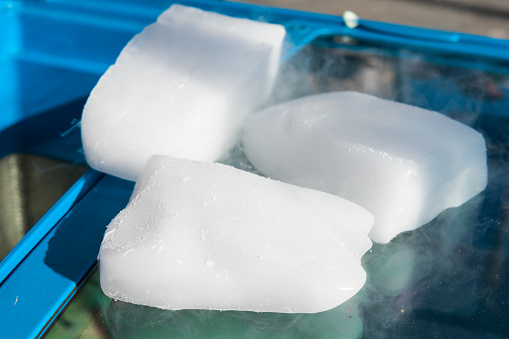on
Freezer failure can mean the loss of all or part of a large investment in food, time, and money. It pays to know what to do if your equipment stops working. The best time to decide how to handle such an emergency is before it happens.
At any time of year, a freezer may fail to function because of mechanical problems, power failures, or human error. When a freezer does fail to work, the first rule is to keep the freezer door closed. In a well-filled freezer, food will probably not thaw for 15-20 hours if the door is kept closed.
Why has it stopped? How long will it be before it’s working again?
When you first notice that your freezer has stopped, try to determine why. It might be something simple like a blown fuse, a broken electrical circuit, or an accidental disconnection. In any of these cases, normal operation should be restored as quickly as possible and the food checked for thawing.
In case of power failure, find out from the utility company how long it will be before power is restored. If your freezer has failed because of mechanical problems, read the instruction book to see if there’s something you can do to get it back into operation. If not, find out how soon the repairman can service your freezer.
What can you do to keep your food from thawing?
If your freezer is not likely to be operating within a day, you have several choices about what to do. First, check the possibility of moving your frozen food to a freezer that is working. You might have friends or neighbors with space in their freezers for your food. You might also check the possibility of moving the freezer contents to a local freezing plant.
To move your food, put it in insulated boxes or between thick layers of newspaper and blankets. Once you’ve taken the food out of your freezer, get it to an operating freezer as soon as possible. When your freezer is empty, unplug it and defrost it according to the instructions in the owner’s manual. After it’s defrosted, clean it thoroughly. While your freezer is not in use, leave the door open slightly to let air circulate in the food compartments. Be sure the door is propped open so that it can’t close and trap a child or pet inside.

If there’s no space available in another freezer, put dry ice in your freezer to keep your food frozen. To locate a source of dry ice in your community, check the yellow pages under “Dry Ice” or Carbonic Gas.” Dry ice is very cold. Handle it quickly and always wear heavy gloves to prevent burning your hands. When you buy dry ice, have it cut into pieces small enough to use. Don’t try to cut or chip it yourself. The dry ice company will wrap each piece in newspaper for you.
A 50-pound cake of dry ice is enough to protect solidly frozen food in a 20-cubic food freezer for 36 hours. Twenty-five pounds of dry ice would hold the temperature of a half-full 10-cubic foot freezer below freezing for two to three days. Put heavy cardboard on top of packages of frozen food in each compartment of your freezer and put the dry ice on top of the cardboard. Close the freezer, but do not lock it. Don’t open the freezer again until you need to replace the dry ice or until the freezer is working again.
You can provide extra insulation for your freezer by covering it with blankets or quilts. Putting insulating packing materials or crumpled newspaper between the cabinet and the blankets will also help. Be sure, however, to fasten coverings away from the air vents on the outside of the freezer. The power may come on unexpectedly and ventilation will be needed.
The gas given off by the dry ice also needs a place to escape. Dry ice is carbon dioxide in its solid form. It evaporates rather than melts and leaves no liquid. You may notice an off-odor after opening a freezer in which dry ice has been stored. The odor is carbonic acid, which is formed by the dry ice and moisture in the freezer. It is harmless to food. Simply leave the freezer door open a few minutes to let it escape.
When there are piles of snow and ice outside, you can use them for temporary storage. Line a plastic garbage can with a clean garbage bag. Put the frozen food in the can, twist, and tie the bag, and put the garbage lid on tightly. Bury the garbage can in snow. Food stored this way should stay frozen for four or five days.
What can you do with thawed food?

Subscribe for FREE to Continue Reading
Subscribe for FREE to get access to all of our premium content and get an email when new content is added.
The purpose of this blog is to present preparedness ideas for those that are brand new to the idea of being prepared for various disasters. We will also provide information for experienced ‘preppers’.
Get access to premium content and more!





